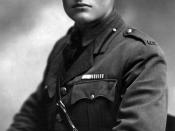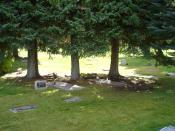Ernest Hemingway greatly utilizes characterization in the short story Hills Like White Elephants. Through close examination, it is evident that the character of Jig is revealed not only through her own actions, but also through the contrasting descriptions of her surrounding environment and her subtle mannerisms. By strategically scattering these faint clues to Jig's persona though out the story, Hemingway forces the reader to overcome common stereotypes and examine ambiguous dialogue before being able to discover the round, dynamic character that is Jig.
Initially, Jig's character is referred to as the girl, (Hemingway 3) implying stereotypical attributes. Her seemingly childish dialogue and actions strengthen her two-dimensional image, and helps guide the casual reader down a misinformed path. An overly simplistic view of Jig may notice the naive overtones in affirmations such as And if I do it you'll be happy and things will be like they were and you'll love me.
(Hemingway 6) but would fail to see the hidden cunning and manipulative side of the statement. Jig's rounded character is revealed only when her statements are closely analyzed and placed into context. When reading the story, it is easy to miss the obvious sarcasm in statements such as And afterward they were all so happy (Hemingway 6) due to the skillful way that Hemingway hides Jig's true inner self.
Jig's inner struggle is mirrored and indirectly shared with us through her contrasting environment and dialogue. The story introduces itself with the gloomy description The hills across the valley of the Ebro were long and white. On this side there was no shade and no trees, (Hemingway 8) which clearly clashes with the fertile description of the opposite side, described as fields of grain and trees along the banks of the Ebro. Far away, beyond the river, were mountains.



Very good
The arguments are made very clear and concise. congrats!
1 out of 1 people found this comment useful.